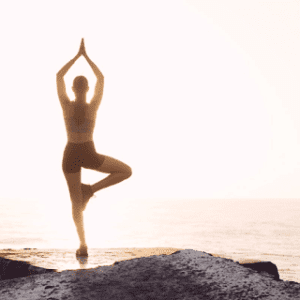 Emily Mattimoe, MS, CTRS, is the coordinator of recreation therapy services at Cottonwood Tucson. She explores how leisure and recreational activities can be coping mechanisms for sobriety and how these methods help add joy to the recovery process.
Emily Mattimoe, MS, CTRS, is the coordinator of recreation therapy services at Cottonwood Tucson. She explores how leisure and recreational activities can be coping mechanisms for sobriety and how these methods help add joy to the recovery process.
Yoga is a vital component of the holistic recreational approach at Cottonwood Tucson.
“Treatment isn’t just about getting counseling—it’s about the whole experience. We truly believe in this idea that it’s the entire body, mind, and spirit that are affected when it comes to recovery,” Mattimoe says. “Many times when people come to us, they’re not only having problems with depression, anxiety, and addiction, they’re also dealing with somatic experiences. Their bodies are hurting.”
Yoga movement and its focus on universal wellness are often considered forms of somatic therapy. Soma is Greek for “living body.” This approach examines the connection between body and mind and uses both physical techniques as well as cognitive or behavioral therapy to release underlying causes for many co-occurring conditions people might face when suffering with addiction.
“A lot of times, they’re disconnected from their spiritual selves. They’re so focused on trying to be functional in life,” Mattimoe says. “One of the pieces that Cottonwood does well is we’re able to meet residents where they’re at, and then maybe pull in the physical aspect and the spiritual aspect and explore how those connections can be such a key element of recovery.”
How does yoga practice help with this?
“Many times, we don’t want to feel emotions, or we don’t want to experience what’s happening in our bodies because it’s so painful. So, what happens is people hold those emotions or trauma in their bodies,” Mattimoe says. “It’s our job as professionals to really help them move all of that through their bodies, then bring some language to it. Afterward, when they feel safe, start touching on those pieces that might be stuffed down.”
The Importance of Participatory Medicine
Cottonwood Tucson presents residents with the theory of participatory medicine that includes not only physical movement, but emotional movement. It’s a form of internal empowerment that Mattimoe says is crucial to the concept of recovery.
“People come in here thinking something external is going to heal them. They’re going to have medication-assisted therapies, or ‘I haven’t able to do it for myself, but this therapist is going to fix me.’ Through participatory medicine, we teach them how to have the mindfulness to be better healers for themselves,” she says. “People aren’t going to be in the Cottonwood bubble for the rest of their lives. Things are going to happen in the real world, but they can use yoga as a mindfulness practice to develop a tolerance for discomfort. For example, ‘I can hold this pose for another 30 seconds, it’s okay, I don’t have to move my foot or react right now.’ Someone learns they don’t have to disconnect from that experience. They can be a little uncomfortable, but still be safe.”
The concepts of ownership and agency are critical to successful recovery.
Mattimoe says people often learn through yoga what matters most to them about the process of healing, and not that they’re doing it for their parents or the cute guy back home. Honoring yourself and being present for yourself are primary messages conveyed through yoga that most people haven’t heard before.
“It’s an ability to understand that we have more impact on ourselves than anyone else does. Some people come in and feel victimized, often for very valid reasons,” Mattimoe says. “It’s our goal to walk them through that feeling of being a victim toward the feeling of ‘I can make changes. I can be an empowering person for myself. I have this toolbox that other people help me put together, yet I’m the person who chooses what tool to use, where I use it, and for how long.'”
Yoga, she says, helps reinforce embrace ownership and agency through the power of choice. “Do I want to hold this pose for another breath, put my hand on a block, or can I push the edge a little more? It’s all about choices and listening to ourselves as to what we truly need,” she says. “Does this feel safe? Does this feel comfortable? Is this too much? Is this too little? We just become more aware of where we are in space, and make choices accordingly.”
The Cottonwood Approach to Yoga
Cottonwood Tucson provides new residents first with a lecture that leads to a yoga practice. The staff intends to help break down any barriers regarding yoga so people can learn about the pieces that are important. Many people have never done yoga, think they can’t do it, or have a concept of it that doesn’t align with what they know. Mattimoe believes one of the best things the staff can do is to help people feel safer and more comfortable while encouraging them to speak up about particular boundaries.
“If someone is willing and open to it, we like to have a conversation about how can we help with any barriers. For example, if someone’s fear is ‘I have trauma, and I don’t want the teacher to touch me in yoga class,’—it’s important to vocalize that, because it’s a great place to start. And then we can ask ‘How do you have control over that, what can you do to address it?’ ‘Well, I can ask the teacher not to touch me.’ And then we assure them the instructors will respect them and this choice.”
Yoga instructors at Cottonwood Tucson are often multi-disciplined in other wellness components, such as counseling, behavioral therapy, and nutrition. They design yoga sessions based on the people in the class, allowing for individual experiences to guide the flow. Teachers often need to be considerate of how different participants have triggers that involve everything from someone standing behind them to trust of strangers, but it’s also important for individuals to find their voices and be open about what they need.
“This is so huge. It’s part of the goals we have of them being here: being able to share honestly what they’re feeling and what’s happening with them without shame, without judgement,” Mattimoe says. “So many times, we feel things are happening to us. Our staff wants to validate that this is their opportunity to have some buy-in. They’ve been feeling out of control, maybe due to depression, isolation, and trauma, or to using. We want to help them regain control.”
Mattimoe notes that addiction creates chaos.
Yoga, she says, is the opposite: it fosters a space of stillness, of calm. “Chaos is often the way we distract ourselves from what’s happening. With yoga, we build a foundation to face all of that,” she said. “People may not have any idea yet what it’s doing for them, but we can hopefully help make small adjustments that have a huge impact.”
What Allows You to Succeed
The professionals at Cottonwood believe communication is fundamental to many aspects of life during treatment and beyond. Through the variety of holistic practices offered at the facility, people develop the mindfulness to acknowledge their experiences, work through them, and step on the path to a more healthy life with the ability to make their voices heard. To learn how this approach may help you, please contact us today.
By Tracey L. Kelley






